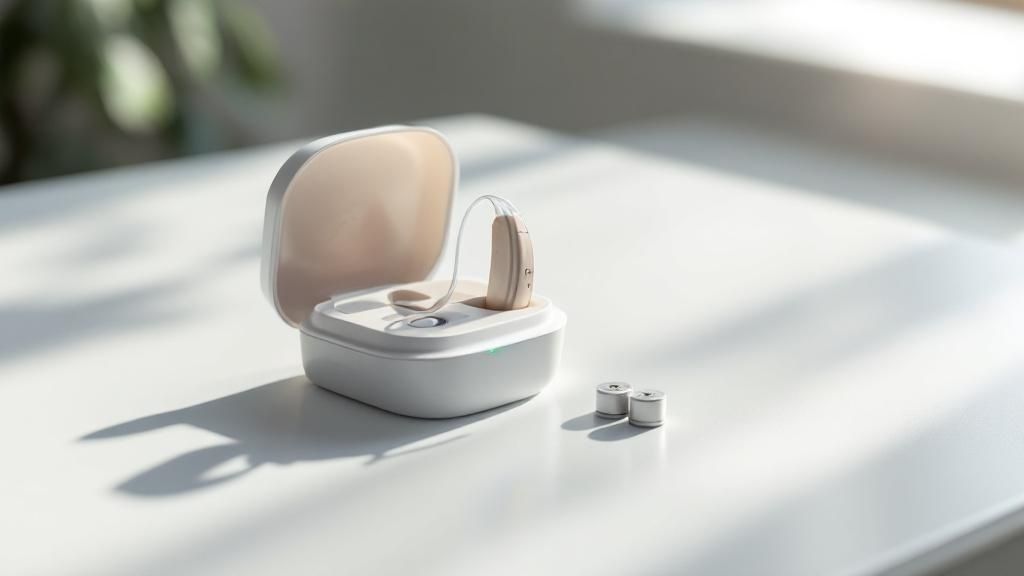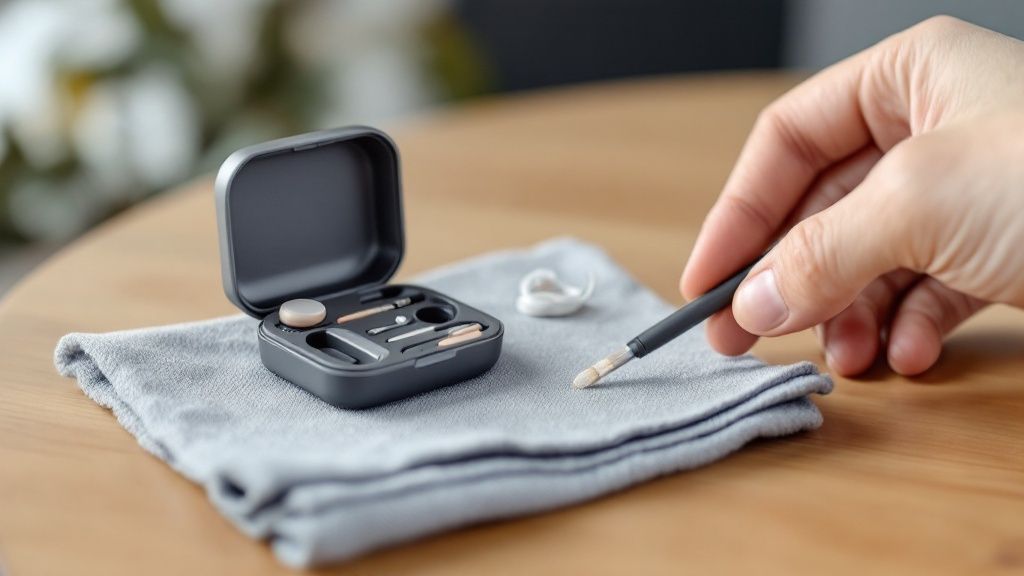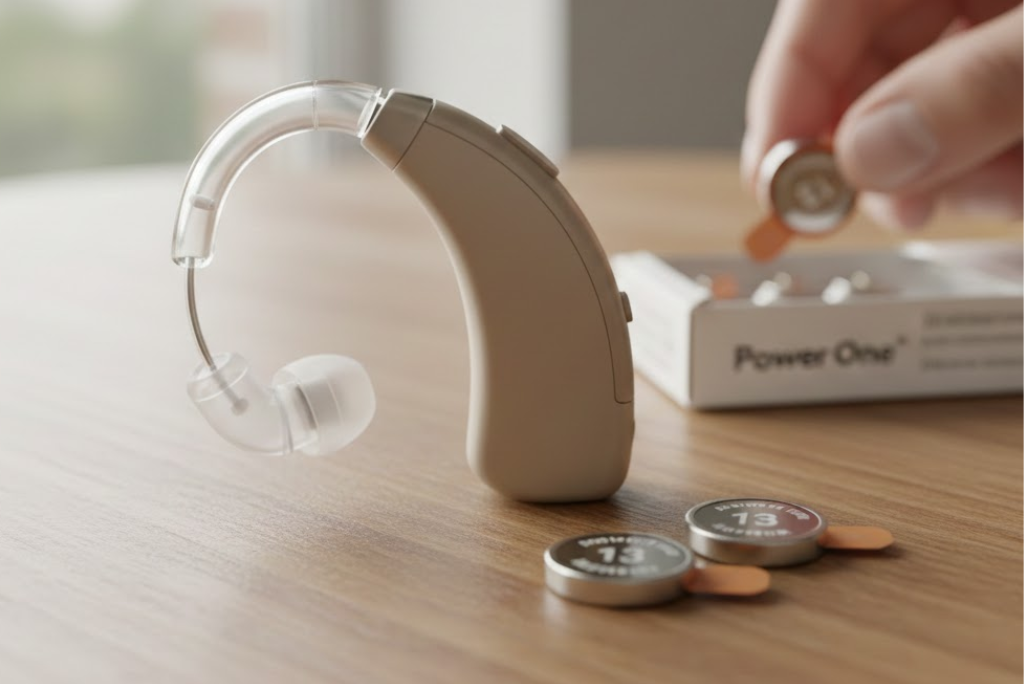It starts with a quiet, almost imperceptible chirp.
That tiny, high-pitched beep is a sound every hearing aid user knows intimately—a private signal that your connection to the vibrant, living world is about to fade. The hearing aid battery life is ending, and doesn't it always seem to happen at the worst possible moment? Just as the symphony swells, just as the secret is about to be told... silence.
Why Hearing Aid Batteries Die at the Worst Times
Imagine leaning in to hear a grandchild's whispered secret, only for their precious voice to dissolve into a frustrating wall of static. Or picture yourself in a bustling restaurant, finally catching the thread of a hilarious story, when the punchline is stolen from you by a dead battery.
This isn't just a technical glitch; it's an emotional gut-punch. It’s that sudden, isolating feeling of being unplugged from the very moments that make up your life.
This creates a subtle, constant worry—a background hum of anxiety. You start to question your device's reliability. Will it last through this important meeting? Can I get through dinner without fumbling for a tiny replacement battery? This anxiety can even make you hesitate to use the advanced features that help you hear best, fearing they’ll drain the power too quickly.
It’s a frustration that feels deeply personal, but it's a universal experience for hearing aid wearers. The good news? You can trade that constant battery anxiety for confident control.
Choosing the Right Hearing Aid Power Option
Every hearing aid runs on one of two battery types: traditional disposable batteries or modern rechargeable ones. Both have their advantages, and the better choice comes down to your daily habits and preferences.
Disposable zinc-air batteries are reliable and easy to replace. They’re a great option if you travel often or prefer the reassurance of carrying backup power with you. Just keep extras on hand, and you’re covered.
Rechargeable hearing aids, on the other hand, offer convenience with a simple overnight charge. They’re ideal for those with consistent routines or who might find swapping tiny batteries challenging.
There’s no one-size-fits-all answer—but understanding how each type fits into your lifestyle can help you stay powered up with less stress.
If you choose the disposable route, battery size matters.

How Battery Size Dictates Your Day
Ever glance at a hearing aid battery pack and feel like you were trying to decipher a secret code? Those numbers—10, 312, 13, 675—aren't random. They're part of a beautifully simple system that communicates a delicate balance between power, size, and how discreet your hearing aid can be. Learning this code is the first step to truly understanding your device's energy needs and its expected hearing aid battery life.
Think of it like choosing the right fuel tank for a car. A tiny, sleek sports car doesn't need a massive gas tank; its design prioritizes agility and a low profile. In the same way, a nearly invisible hearing aid is built around a compact power source. On the other hand, a powerful truck designed for heavy hauling needs a much larger tank to fuel its demanding engine.
This is the exact logic behind hearing aid battery sizes. Each number corresponds to a different physical size, which directly dictates its energy capacity and how long it will keep your hearing aid running.
How Battery Color Codes Help You Choose the Right Size
The world of disposable hearing aid batteries is built on four standard sizes. To make life easier, each one is color-coded, so you can grab the right pack without squinting at the tiny print. Understanding what each size was designed for will tell you a lot about why your audiologist recommended a specific device for you.
- Size 10 (Yellow): This is the smallest of the bunch. It’s made for the most discreet hearing aids out there, like completely-in-canal (CIC) models. Its tiny form factor means a shorter lifespan, typically 3 to 7 days, but it’s what allows the hearing aid to stay virtually hidden.
- Size 312 (Brown): This is the versatile sweet spot. The Size 312 offers a fantastic blend of compact size and reasonable power, making it small enough for many in-the-ear (ITE) and mini behind-the-ear (BTE) devices while lasting a solid 3 to 10 days.
- Size 675 (Blue): Meet the powerhouse. The largest of the four, the Size 675 is reserved for high-power BTE hearing aids built for people with severe to profound hearing loss. It packs the most juice, delivering an impressive 9 to 20 days of life.
It's really no surprise that the Size 312 battery is the most popular choice on the market. In fact, it commands a huge 38.2% share of the hearing aid battery industry. Its widespread use in both BTE and ITE models shows just how well it balances a discreet design with dependable battery life, making it a favorite for users with moderate to severe hearing needs. You can learn more about what's driving this trend in the full hearing aid battery market report.
Why Your Device Demands a Specific Size (And Why You Can’t Swap)
You can't just pop a Size 10 battery into a hearing aid built for a Size 13. The battery compartment is precision-engineered to fit one size and one size only. But this isn't just about physical fit; the design choice goes much deeper.
A hearing aid's size is determined by two critical things: the level of amplification it needs to provide and the technology packed inside. A device built to correct profound hearing loss simply requires more power—and larger internal parts—than one made for someone with mild hearing loss.
The battery size isn't just a component; it's the heart of the device's entire design philosophy. The manufacturer chose it to perfectly match the hearing aid's power requirements, physical dimensions, and feature set.
Think about modern features like Bluetooth streaming or advanced noise reduction. These functions are incredibly power-hungry. Streaming music or taking calls directly through your hearing aids is like running a demanding app on your phone—it drains the battery fast. A hearing aid loaded with this kind of tech will almost always need a larger battery, like a Size 13 or 312, to support that activity without dying in a day or two.
So, when you look at your hearing aid battery, you're not just seeing a number. You're seeing the result of a careful engineering decision that balances the sounds you need to hear with the life you want to live.
What Drains Hearing Aid Batteries Faster
The biggest power draw comes from advanced features like Bluetooth streaming, which allows you to take calls or listen to music directly through your hearing aids. While convenient, streaming sends a constant signal that demands extra energy. Similarly, features like noise reduction, feedback cancellation, and tinnitus masking require your device to run complex audio processing in real time. The more frequently these are active—like in loud environments—the faster your battery will run down.
Environmental conditions also have an impact. High heat accelerates the chemical reactions inside the battery, causing it to deplete more quickly. Cold temperatures can slow these reactions, reducing battery performance and causing the hearing aids to appear underpowered. Humidity is another issue, especially for disposable zinc-air batteries. Excess moisture can cause corrosion, while extremely dry air (like in heated indoor spaces during winter) can cause the battery to dry out too fast.
Even earwax and moisture buildup can take a toll. When key parts like the microphone or battery contacts are partially blocked, your hearing aids have to work harder to deliver the same output, which results in faster energy drain.
Understanding these hidden drains on power helps you build habits that protect your battery life, keeping your hearing aids reliable throughout the day.
Simple Habits That Extend Hearing Aid Battery Life
Simple daily habits can go a long way in extending your hearing aid battery life. These aren’t complex fixes—just small, consistent actions that can make a big difference in performance and reliability.
Start with your disposable battery routine. When installing a new zinc-air battery, wait 3 to 5 minutes after removing the tab before inserting it into your hearing aid. This gives the battery time to fully activate by absorbing oxygen—jumpstarting the chemical reaction that powers your device. Skipping this step can shorten the battery’s life by days.
At the end of the day, open the battery door. This disconnects the power and helps prevent tiny drains overnight. It also allows moisture to evaporate, protecting the battery and internal contacts from corrosion.
Moisture is a major enemy of battery life. Using a hearing aid dehumidifier overnight pulls out humidity and keeps the internal components dry—especially helpful in humid climates or after sweaty days. It's a simple step that protects your battery and device.
Lastly, keep your hearing aids clean. Buildup from earwax or debris can block the microphone or receiver ports, forcing your hearing aid to work harder and burn through power faster. A quick wipe-down or regular cleaning keeps things running more efficiently.
These small habits add up to fewer dead batteries, fewer interruptions, and more reliable hearing throughout the day.
Your Daily Battery Life Checklist
To make this even easier, here's a quick-reference table. Think of it as a daily checklist to ensure you're getting the absolute most out of every single charge or battery.
| Action | Why It Works | Battery Type (Disposable/Rechargeable/Both) |
|---|---|---|
| Wait 3-5 mins after removing tab | Allows the zinc-air battery to fully activate by absorbing oxygen, maximizing its power potential. | Disposable |
| Open the battery door at night | Disconnects the battery to stop overnight power drain and allows moisture to evaporate, preventing corrosion. | Disposable |
| Charge every night | Ensures you start each day with 100% power and keeps the lithium-ion battery in its optimal state. | Rechargeable |
| Use a dehumidifier nightly | Removes damaging moisture, which reduces electrical strain and prevents corrosion. | Both |
| Keep devices clean | Prevents blocked ports that force the amplifier to work harder, consuming more power. | Both |
| Store in the official charger | Protects the device and ensures it's ready to go. Modern chargers prevent overcharging. | Rechargeable |
Following these simple steps will quickly become second nature, giving you more reliable performance and peace of mind.
How to Charge Hearing Aids the Right Way
For those with rechargeable hearing aids, the habits are different, but the goal is the same: protecting the long-term health of your battery. The lithium-ion batteries in your hearing aids have a finite number of charge cycles, and good charging habits help you get the most out of every single one.
The best practice is surprisingly simple: get into a consistent nightly routine.
- Charge Every Night: Don't wait for the low-battery warning. Pop your hearing aids in their charger every night to make sure you start each day with a full 100% charge.
- Use the Right Gear: Always stick with the charger and cable that came with your device. They're specifically designed to deliver the right voltage and current to keep your battery healthy.
- The Charger is Home Base: When you're not wearing them, the charger is the safest place for your hearing aids. Modern chargers are smart—they stop sending power once the battery is full, so there’s no risk of overcharging.
By adopting these habits, you stop being a spectator and become an active participant in your hearing aid's performance. Each small action adds up, giving you more reliability, more confidence, and more time connected to the sounds that matter.
Common Hearing Aid Battery Questions and Answers
Even when you're doing everything right, questions about your hearing aid batteries are bound to pop up. Think of this as your quick-reference guide for the most common puzzles, designed to give you clear, straightforward answers so you can stay powered up and connected.
Why Is My Brand-New Hearing Aid Battery Dying So Fast?
If a new battery is giving up the ghost way too soon, there are a few usual suspects. First, after you peel off that little sticker on a disposable battery, let it sit for a full 3-5 minutes before you pop it in. That little pause lets the zinc-air chemistry fully activate, giving it the juice it needs to perform.
Another big power drain is heavy feature usage. If you're streaming music or podcasts via Bluetooth or relying on advanced noise-cancellation in a busy restaurant, your battery is working overtime. It’s also worth noting that extreme cold or high humidity can slash a battery’s lifespan. If you've checked all these boxes and the problem continues, you might just have a bad or old battery on your hands.
Can I Just Use a Regular Watch Battery in My Hearing Aid?
Absolutely not. It might seem like a clever hack, but this is one corner you should never cut. Hearing aid batteries are specifically designed zinc-air cells that activate with air and deliver a steady, stable voltage that your device's sensitive electronics depend on.
A watch battery uses a completely different chemistry, like silver-oxide, and its voltage can fluctuate in ways that will fry the intricate components inside your hearing aid. Sticking to the exact size and type recommended for your device isn't just a suggestion—it's essential for protecting your investment.
Is It Bad to Leave My Rechargeable Hearing Aids in the Charger All the Time?
Nope, it’s not bad at all—in fact, it's the best thing you can do for them. Modern rechargeable hearing aids, like the ones from HearDirectClub, come with "smart" chargers. These chargers are designed to automatically shut off once the batteries hit 100%.
This prevents any risk of overcharging and actually helps protect the long-term health of your batteries. Keeping your hearing aids in their charger when you're not wearing them is the best way to ensure they’re always ready to go when you are. And if you’re running into other quirks, our comprehensive hearing aid troubleshooting guide has answers for other common issues you might face.
Ready for a hearing solution that combines crystal-clear sound with the convenience of a long-lasting rechargeable battery? Discover how HearDirectClub delivers up to two full days of power on a single charge. Experience the freedom of effortless hearing by visiting https://heardirectclub.com.





Leave a comment
This site is protected by hCaptcha and the hCaptcha Privacy Policy and Terms of Service apply.